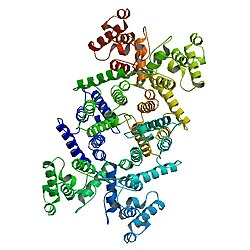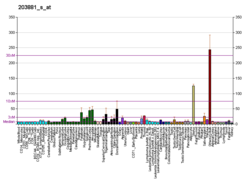
Back ديستروفين Arabic Distrofin BS Distrofina Catalan Dystrofin Czech DMD Welsh Dystrophin German Distrofina Spanish Dystrophine French Distrofina Galician דיסטרופין HE

Dystrophin is a rod-shaped cytoplasmic protein, and a vital part of a protein complex that connects the cytoskeleton of a muscle fiber to the surrounding extracellular matrix through the cell membrane. This complex is variously known as the costamere or the dystrophin-associated protein complex (DAPC). Many muscle proteins, such as α-dystrobrevin, syncoilin, synemin, sarcoglycan, dystroglycan, and sarcospan, colocalize with dystrophin at the costamere. It has a molecular weight of 427 kDa [5][6]
Dystrophin is coded for by the DMD gene – the largest known human gene, covering 2.4 megabases (0.08% of the human genome) at locus Xp21. The primary transcript in muscle measures about 2,100 kilobases and takes 16 hours to transcribe;[7] the mature mRNA measures 14.0 kilobases.[8] The 79-exon muscle transcript[9] codes for a protein of 3685 amino acid residues.[10]
Spontaneous or inherited mutations in the dystrophin gene can cause different forms of muscular dystrophy, a disease characterized by progressive muscular wasting. The most common of these disorders caused by genetic defects in dystrophin is Duchenne muscular dystrophy.
- ^ a b c GRCh38: Ensembl release 89: ENSG00000198947 – Ensembl, May 2017
- ^ a b c GRCm38: Ensembl release 89: ENSMUSG00000045103 – Ensembl, May 2017
- ^ "Human PubMed Reference:". National Center for Biotechnology Information, U.S. National Library of Medicine.
- ^ "Mouse PubMed Reference:". National Center for Biotechnology Information, U.S. National Library of Medicine.
- ^ Lederfein D, Levy Z, Augier N, Mornet D, Morris G, Fuchs O, et al. (June 1992). "A 71-kilodalton protein is a major product of the Duchenne muscular dystrophy gene in brain and other nonmuscle tissues". Proceedings of the National Academy of Sciences of the United States of America. 89 (12): 5346–50. Bibcode:1992PNAS...89.5346L. doi:10.1073/pnas.89.12.5346. PMC 49288. PMID 1319059.
- ^ "DMD - Dystrophin - Homo sapiens (Human) - DMD gene & protein". www.uniprot.org. Retrieved 1 December 2021.
- ^ Tennyson CN, Klamut HJ, Worton RG (February 1995). "The human dystrophin gene requires 16 hours to be transcribed and is cotranscriptionally spliced". Nature Genetics. 9 (2): 184–90. doi:10.1038/ng0295-184. PMID 7719347. S2CID 7858296.
- ^ NCBI Sequence Viewer v2.0
- ^ Strachan T and Read AP, 1999. Human molecular genetics, BIOS Scientific, New York, USA
- ^ "dystrophin isoform Dp427c [Homo sapiens] - Protein - NCBI". www.ncbi.nlm.nih.gov.
© MMXXIII Rich X Search. We shall prevail. All rights reserved. Rich X Search






